

Universität Düsseldorf: Psychology. MhGAP:Psicosis. The Hardest Science – A psychology blog. Thoughts about the mind, science, society, and whatever else. R Psychologist. Institute of Psychology - University of Bern. Methodology & Statistics - Faculty of Social and Behavioural Sciences. Psychology - University of Amsterdam. The UvA website uses cookies and similar technologies to ensure the basic functionality of the site and for statistical and optimisation purposes.
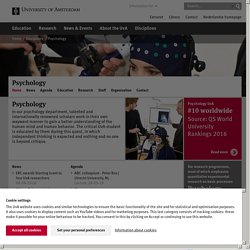
It also uses cookies to display content such as YouTube videos and for marketing purposes. This last category consists of tracking cookies: these make it possible for your online behaviour to be tracked. You consent to this by clicking on Accept or continuing to use this website. Necessary Cookies that are essential for the basic functioning of the website. Optimalisation & Necessary Cookies that collect information about visitor behaviour anonymously to help make the website work more effectively.
Marketing, Optimalisation & Necessary Cookies that make it possible to track visitors and show them personalised adverts. Effect Size Calculator. Soviet Psychology: The Vygotsky Internet Archive. Universität Düsseldorf: G*Power. Recommended Readings on PLS-SEM - pls-sems Webseite! Rigdon, E.

E., Sarstedt, M., Ringle, C. Sins and virtues. Angels and Demons. The Whole Brain Atlas. Digital Anatomist Interactive Atlases. Structural Informatics GroupDepartment of Biological StructureUniversity of Washington Seattle, Washington, USA Atlases Content: 2-D and 3-D views of the brain from cadaver sections, MRI scans, and computer reconstructions.Author: John W.
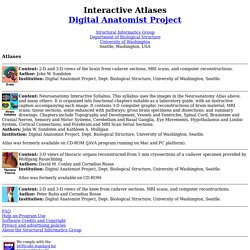
SundstenInstitution: Digital Anatomist Project, Dept. Biological Structure, University of Washington, Seattle. Content: Neuroanatomy Interactive Syllabus. BrainInfo. Neuropsychology: A Multimedia Course. The Psychometrics Centre. Artículos de Psicoterapia Integrativa: La estructura del yo, función intrapsíquica y mecanismos de defensa: los conceptos originales de Berne.: Richard Erskine. La estructura del yo, función intrapsíquica y mecanismos de defensa: los conceptos originales de Berne.

Richard G. Erskine Traducción revisada por Jesús Cuadra. La extensión del pensamiento psicoanalítico traída por Eric Berne(1961) descansa sobre la elaboración y la puesta en aplicación que ha extraido de una idea introducida por Paul Federn(1953), la de las subdivisiones en el interior del yo. Maturana para principiantes: La biología del amar y del conocer. Hace poco, Humberto Maturana (1928) se vio envuelto en una polémica respecto al coaching y la naturaleza de sus propias investigaciones.
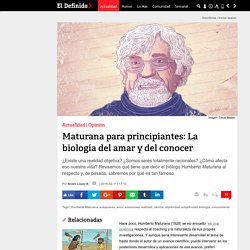
Y aunque sería interesante desarrollar el tema de hasta donde el autor de un avance científico, puede intervenir en los posteriores desarrollos y aplicaciones de ese avance, preferí enfocarme en lo que me parece que ha sido el gran legado del Dr. Maturana: La biología del amar y del conocer. Algunos antecedentes: autopoiesis, realidad y lenguaje.
Classics in the History of Psychology. Classics in the History of Psychology An internet resource developed byChristopher D.

Green , ISSN 1492-3713 (Return to index) On Small Differences in Sensation. Pat Langley. Charles Sanders Peirce. 1.

Brief Biography. Untitled. Jon Juaristi: El bucle melancólico.
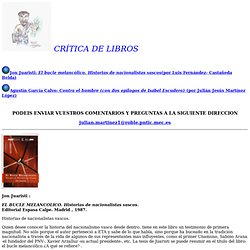
Iletrismo-Recurso a las propuestas de Gottlob Frege, Luisa M. Matallana. English Home Page.
Neuro. In Brain, Competing Thoughts Come in Waves and Rhythms. Generation Next Blog ← Grown-up fun or girls behaving badly?
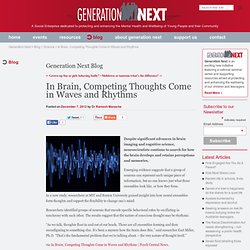
• Meltdown or tantrum-what’s the difference? In Brain, Competing Thoughts Come in Waves and Rhythms. Sensory substitution. Sensory substitution means to transform the characteristics of one sensory modality into stimuli of another sensory modality. It is hoped that sensory substitution systems can help handicapped people by restoring their ability to perceive a certain defective sensory modality by using sensory information from a functioning sensory modality. A sensory substitution system consists of three parts: a sensor, a coupling system, and a stimulator. The sensor records stimuli and gives them to a coupling system which interprets these signals and transmits them to a stimulator. In case the sensor obtains signals of a kind not originally available to the bearer it is a case of sensory augmentation. 15 Styles of Distorted Thinking. 15 Styles of Distorted Thinking. World's most detailed scans will reveal how brain works.
5 March 2013Last updated at 13:27 ET By Pallab Ghosh Science correspondent, BBC News Continue reading the main story Daydream Believer: an MRI scan of the brain at rest.
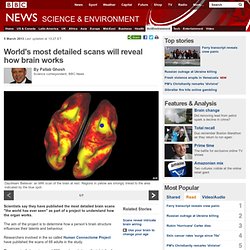
Regions in yellow are strongly linked to the area indicated by the blue spot. BrainVISA/Anatomist Home Page. Brain Structures and Their Functions. The nervous system is your body's decision and communication center. The central nervous system (CNS) is made of the brain and the spinal cord and the peripheral nervous system (PNS) is made of nerves. Together they control every part of your daily life, from breathing and blinking to helping you memorize facts for a test.
Nerves reach from your brain to your face, ears, eyes, nose, and spinal cord... and from the spinal cord to the rest of your body. Sensory nerves gather information from the environment, send that info to the spinal cord, which then speed the message to the brain. THE BRAIN FROM TOP TO BOTTOM. Learning Strategies. Mind Tools. Hacking Knowledge: 77 Ways To Learn Faster, Deeper, & Better. If someone granted you one wish, what do you imagine you would want out of life that you haven’t gotten yet? For many people, it would be self-improvement and knowledge. Newcounter knowledge is the backbone of society’s progress.
The Primacy of Consciousness - Peter Russell - Full Version. Consciousness. Quantum mind–body problem. An interpretation of quantum mechanics is a set of statements which attempt to explain how quantum mechanics informs our understanding of nature. Although quantum mechanics has held up to rigorous and thorough experimental testing, many of these experiments are open to different interpretations. There exist a number of contending schools of thought, differing over whether quantum mechanics can be understood to be deterministic, which elements of quantum mechanics can be considered "real", and other matters. This question is of special interest to philosophers of physics, as physicists continue to show a strong interest in the subject.
Our brains are wired so we can better hear ourselves speak, new study shows. Like the mute button on the TV remote control, our brains filter out unwanted noise so we can focus on what we’re listening to. But when it comes to following our own speech, a new brain study from the University of California, Berkeley, shows that instead of one homogenous mute button, we have a network of volume settings that can selectively silence and amplify the sounds we make and hear. Activity in the auditory cortex when we speak and listen is amplified in some regions of the brain and muted in others. In this image, the black line represents muting activity when we speak. (Courtesy of Adeen Flinker) Neuroscientists from UC Berkeley, UCSF and Johns Hopkins University tracked the electrical signals emitted from the brains of hospitalized epilepsy patients.
Their findings, published today (Dec. 8, 2010) in the Journal of Neuroscience, offer new clues about how we hear ourselves above the noise of our surroundings and monitor what we say. Mapping the human brain connectivity. Integral theory. Integral theory, a philosophy with origins in the work of Sri Aurobindo and Jean Gebser, and promoted by Ken Wilber, seeks a synthesis of the best of pre-modern, modern, and postmodern reality.[1] It is portrayed as a "theory of everything,"[2] and offers an approach "to draw together an already existing number of separate paradigms into an interrelated network of approaches that are mutually enriching. "[1] It has been applied by scholar-practitioners in 35 distinct academic and professional domains as varied as organizational management and art.[1] Methodologies[edit] AQAL, pronounced "ah-qwul," is a widely used framework in Integral Theory. It is also alternatively called the Integral Operating System (IOS) or by various other synonyms.
Sri Aurobindo, Jean Gebser, and Ken Wilber, have all made significant theoretical contributions to integral theory. AQAL Theory – Lines.